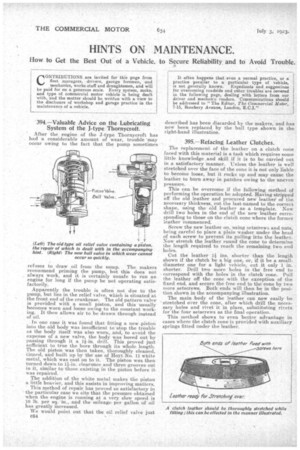HINTS ON MAINTENANCE.
Page 44

If you've noticed an error in this article please click here to report it so we can fix it.
flow to Get the Best Out of a Vehicle, to Secure Reliability and to Avoid Trouble.
'394.—Valuable Advice on the Lubricating . System of the j-type Thornycroft.
After the engine of tile J-type Thornycroft has had a considerable amount of wear, trouble may occur owing to the fact that the pump sometimes refuses to draw oil from the stamp. The makers recommend priming the pump, but this does not always work, and it is certainly unsafe to run an engine for long if the pump be not operating satisfactorily.
Apparently the trouble is often not due to the pump, but lies in the relief valve, which is situated at the front end of the crankcase. The old pattern valve' is provided with a small piston, and this usually becomes worn and loose owing to the constant working. It then allows air to be drawn through instead of oil.
In one case it was found that fitting a new-piston into the old body was insufficient to stop the trouble as the body itself was also worn, and, to avoid the expense of a new valve, the body was bored out by passing through it a 1-in. drill. This proved just sufficient to true the bore through its whole length. The old piston was then taken, thoroughly cleaned, tinned, and built up by the use of Hoyt No. 11 white metal, which was east on to it. The piston was then turned down to 1k-in, clearance and three grooves cut in it, similar to those existing in the piston before itwas repaired. •
The addition of the white metal makes the piston a little heavier, and this assists in improving matters.
This method of repair has proved so satisfactory in the particular case we cite that the pressure obtained when the engine is running at a -very slow speed is 10 lb. per sq. in., and the mileage per gallon of oil has greatly increased.
We would point out that the oil relief valve just
G,54
described has been discarded by the makers, and has now been replaced by the ball type shown in the right-hand illustration.
• 395.---Refacing Leather Clutches.
The replacement of the leather on a clutch cone faced•with this material is a task which requires some little knowledge and skill if it is to be. carried out in a satisfactory 'manner. Unless the leather is well stretched over the face of the cone it is not only liable to became loose, but it rucks up and may cause the leather to burn away in patches owing to the uneven pressure.
This can • be overcome if the following method of performing the operation be adopted. Having stripped off the old leather and procured new leather of the necessary thickness, cut the last-named to the correct shape, using the old leather asa template. ' Now drill two holes in the end of the new leather corresponding to those on the clutch cone where the former leather commenced.
Screw the new leather on, using setscrews and nuts, being careful to place a plain washer under the head of each screw to prevent its pulling into the leather. Now stretch the leather round the cone to determine the length required to reach the remaining two end holes.
Cut the leather 1* ins, shorter than the length shown if the clutch be a big one, or, if it be a small diameter one for a light vehicle, cut it only 1 in. i .. shorter. Drill two more holes n the free end to correspond with the holes in the clutch cone. Pull the leather off the cone with the exception of the fixed end, and secure the free end to the cone by two more setscrews. Bath ends will then be in the position shown in the accompanying illustration.
The main body of the leather can now easily be ' stretched over the cone, after which drill the necessary holes and rivet it in place, substituting rivets for the four setscrews as the final operation.
This method shows to even better advantage in cases where the clutch cone is provided with auxiliary springs fitted under the leather.














































